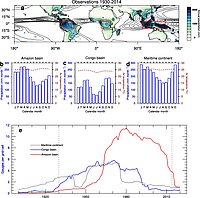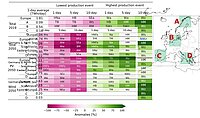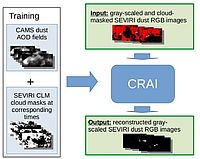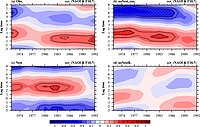Meldungsarchiv

a Mean annual precipitation from GPCC 1930–2014, whereas the contours show the monthly-mean precipitation rates in mm day–1 from the GPCP satellite-derived dataset 1979–2014 (only values of 3 mm day–1 are contoured at the interval of 1 mm day–1). b–d (left axis) annual cycle of land precipitation (bar plots) averaged over the Amazon basin (5° N–10° S, 50–80° W), Congo basin (5° N–10° S, 10–30° E), and Maritime continent (5° N–10° S, 100–150° E) shown by the red boxes in a. The right axis in b–d shows the annual cycle of 2-m air temperature represented by the dashed line. e Number of rain gauges within a grid-cell averaged over the Amazon basin (red), Congo basin (blue), and Maritime continent (grey). Dashed vertical lines in e delineate the study period 1930–2014. Note that for the area-average over the humid tropic regions, only land grid points included to the boxes are considered
- Februar 2024:
neue Veröffentlichung:Nnamchi, H.C., Diallo, I. Inconsistent Atlantic Links to Precipitation Extremes over the Humid Tropics. Earth Systems Environment (2024). https://doi.org/10.1007/s41748-023-00370-0
Abstract:
This study investigates extreme wet and dry conditions over the humid tropics and their connections to the variability of the tropical ocean basins using observations and a multi-model ensemble of 24 state-of-the-art coupled climate models, for the 1930–2014 period. The extreme wet (dry) conditions are consistently linked to Central Pacific La Niña (Eastern Pacific El Niño), the weakest being the Congo basin, and homogeneous patterns of sea surface temperature (SST) variability in the tropical Indian Ocean. The Atlantic exhibits markedly varying configurations of SST anomalies, including the Atlantic Niño and pan-Atlantic decadal oscillation, with non-symmetrical patterns between the wet and dry conditions. The oceanic influences are associated with anomalous convection and diabatic heating partly related to variations in the strength of the Walker Circulation. The observed connection between the Amazon basin, as well as the Maritime continent, and the Indo-Pacific variability are better simulated than that of the Congo basin. The observed signs of the Pacific and Indian SST anomalies are reversed for the modelled Congo basin extreme conditions which are, instead, tied to the Atlantic Niño/Niña variability. This Atlantic–Congo basin connection is related to a too southerly location of the simulated inter-tropical convergence zone that is associated with warm SST biases over the Atlantic cold tongue. This study highlights important teleconnections and model improvements necessary for the skillful prediction of extreme precipitation over the humid tropics.
- Februar 2024:
neue Veröffentlichung:Huo, W., Drews, A., Martin, T., & Wahl, S. (2024). Impacts of North Atlantic model biases on natural decadal climate variability. Journal of Geophysical Research: Atmospheres, 129, e2023JD039778. https://doi.org/10.1029/2023JD039778
Plain Language Summary:
A long-standing cold bias in the North Atlantic in climate models could be reduced by increasing the horizontal resolution, but we are often limited by computational resources. Here we embedded a nest with 1/10° resolution in the ocean in the North Atlantic in a global chemistry-climate model (called FOCI-VIKING10). It can largely reduce the North Atlantic cold bias (roughly 50%) and correct the path of the North Atlantic current (NAC). North Atlantic Oscillation (NAO) subdecadal variability (a period of 8 years) can be simulated by FOCI-VIKING10 when the representations of the NAO-forced anomalies and the ocean feedback are improved by alleviating the biases. The reported NAO-like responses to the 11-year solar cycle are confirmed in the 9-member ensemble mean with FOCI (non-eddying). Although the solar signals are also found in a single member with FOCI-VIKING10, we cannot rule out the aliasing of the internal variability in this single short member. For detecting a weak or varying signal of external forcings like the 11-year solar cycle in this study, a large ensemble with a “coarse” resolution model is favorable over a single realization with a “presumably” better model.

Weather patterns associated with the lowest (magenta) and highest (green) production events that last at least one, five, and ten days for Europe and for the four regions marked on the map (A–D, see Methods). Blue marks where weather patterns leading to production extremes change from scenario-2050 to scale-2019.
- Februar 2024:
neue Veröffentlichung:Ho-Tran, L., Fiedler, S. A climatology of weather-driven anomalies in European photovoltaic and wind power production. Commun Earth Environ 5, 63 (2024). https://doi.org/10.1038/s43247-024-01224-x
Summary : "In this research we analyze the spatiotemporal variability of photovoltaic (PV) and wind power production in Europe associated with a classification of 29 weather patterns. The results identify specific weather patterns linked to anomalously low PV plus wind power production and how they depend on the region, installed capacity, and event duration."

Schematic illustration of this study's set-up. This study relies on the publicly available climatereconstructionAI (CRAI) code (blue box). To train the CRAI we use a combination of dust aerosol optical depth fields provided by Copernicus Atmosphere Monitoring Service and the Meteosat Second Generation-Spinning Enhanced Visible and Infrared Imager (SEVIRI) cloud mask product CLM provided by EUMETSAT (gray-framed box). Once trained, we provide gray-scaled images, we derived from the SEVIRI Dust RGB product, combined with the corresponding cloud mask as input (upper green box). The CRAI provides reconstructed gray-scaled images, in which cloud-masked pixels have been in-painted as output (lower green box).
- Januar 2024:
neue Veröffentlichung:Kanngießer, F., & Fiedler, S. (2024). “Seeing” beneath the clouds—Machine-learning-based reconstruction of North African dust plumes. AGU Advances, 5, e2023AV001042. https://doi.org/10.1029/2023AV001042
Abstract: Mineral dust is one of the most abundant atmospheric aerosol species and has various far-reaching effects on the climate system and adverse impacts on air quality. Satellite observations can provide spatio-temporal information on dust emission and transport pathways. However, satellite observations of dust plumes are frequently obscured by clouds. We use a method based on established, machine-learning-based image in-painting techniques to restore the spatial extent of dust plumes for the first time. We train an artificial neural net (ANN) on modern reanalysis data paired with satellite-derived cloud masks. The trained ANN is applied to cloud-masked, gray-scaled images, which were derived from false color images indicating elevated dust plumes in bright magenta. The images were obtained from the Spinning Enhanced Visible and Infrared Imager instrument onboard the Meteosat Second Generation satellite. We find up to 15% of summertime observations in West Africa and 10% of summertime observations in Nubia by satellite images miss dust plumes due to cloud cover. We use the new dust-plume data to demonstrate a novel approach for validating spatial patterns of the operational forecasts provided by the World Meteorological Organization Dust Regional Center in Barcelona. The comparison elucidates often similar dust plume patterns in the forecasts and the satellite-based reconstruction, but once trained, the reconstruction is computationally inexpensive. Our proposed reconstruction provides a new opportunity for validating dust aerosol transport in numerical weather models and Earth system models. It can be adapted to other aerosol species and trace gases.
| 2023 News Archive | 2022 News Archive |



